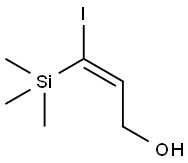(IODOMETHYL)TRIMETHYLSILANE
Synonym(s):(Trimethylsilyl)methyl iodide
- CAS NO.:4206-67-1
- Empirical Formula: C4H11ISi
- Molecular Weight: 214.12
- MDL number: MFCD00001077
- EINECS: 224-123-6
- SAFETY DATA SHEET (SDS)
- Update Date: 2024-08-08 18:06:34

What is (IODOMETHYL)TRIMETHYLSILANE?
Chemical properties
CLEAR YELLOW TO BROWN LIQUID
Physical properties
bp 140–142 °C; d 1.442 g cm?3.
The Uses of (IODOMETHYL)TRIMETHYLSILANE
(Iodomethyl)trimethylsilane is used for the N-alkylation of amides, in a reaction sequence to prepare unstabilized ylides for [2+3]-cycloadditions. It can react with acetoacetic acid ethyl ester to get 3-trimethylsilanyl-proπonic acid ethyl ester.
The Uses of (IODOMETHYL)TRIMETHYLSILANE
(Iodomethyl)trimethylsilane can be used as electrophile for the preparation of allylsilanes and propargylsilanes; forms carbon alkylation adducts useful for alkene synthesis; alkylation adducts are frequently a source of fluorideinduced reactive intermediates, forming nitrogen and sulfur alkylation adducts that function as ylide precursors; readily undergoes metal–halogen exchange to generate a reagent for Peterson methylenation.
Purification Methods
If slightly violet in colour, wash it with aqueous 1% sodium metabisulfite, H2O, dry (Na2SO4) it and fractionally distil it at 760mm. [Whitmore & Sommer J Am Chem Soc 68 481 1946, Beilstein 4 IV 3878.]
Properties of (IODOMETHYL)TRIMETHYLSILANE
| Melting point: | 137-141 °C |
| Boiling point: | 139-141 °C (lit.) |
| Density | 1.443 g/mL at 25 °C (lit.) |
| refractive index | n |
| Flash point: | 89 °F |
| storage temp. | Keep in dark place,Inert atmosphere,2-8°C |
| solubility | Difficult to mix. |
| form | clear liquid |
| Specific Gravity | 1.441 |
| color | Colorless to Light orange to Yellow |
| Sensitive | Light Sensitive |
| Hydrolytic Sensitivity | 3: reacts with aqueous base |
| BRN | 1731485 |
| CAS DataBase Reference | 4206-67-1(CAS DataBase Reference) |
Safety information for (IODOMETHYL)TRIMETHYLSILANE
| Signal word | Warning |
| Pictogram(s) |
 Flame Flammables GHS02  Exclamation Mark Irritant GHS07 |
| GHS Hazard Statements |
H226:Flammable liquids H315:Skin corrosion/irritation H319:Serious eye damage/eye irritation H335:Specific target organ toxicity, single exposure;Respiratory tract irritation |
| Precautionary Statement Codes |
P210:Keep away from heat/sparks/open flames/hot surfaces. — No smoking. P302+P352:IF ON SKIN: wash with plenty of soap and water. P305+P351+P338:IF IN EYES: Rinse cautiously with water for several minutes. Remove contact lenses, if present and easy to do. Continuerinsing. |
Computed Descriptors for (IODOMETHYL)TRIMETHYLSILANE
| InChIKey | VZNYXGQMDSRJAL-UHFFFAOYSA-N |
New Products
Tert-butyl bis(2-chloroethyl)carbamate 4-Methylphenylacetic acid N-Boc-D-alaninol N-BOC-D/L-ALANINOL N-octanoyl benzotriazole 3-Morpholino-1-(4-nitrophenyl)-5,6-dihydropyridin- 2(1H)-one Furan-2,5-Dicarboxylic Acid DIETHYL AMINOMALONATE HYDROCHLORIDE 1,1’-CARBONYLDIIMIDAZOLE R-2-BENZYLOXY PROPIONIC ACID 1,1’-CARBONYLDI (1,2-4 TRIAZOLE) N-METHYL INDAZOLE-3-CARBOXYLIC ACID (2-Hydroxyphenyl)acetonitrile 4-Bromopyrazole 5-BROMO-2CYANO PYRIDINE 5,6-Dimethoxyindanone 5-broMo-2-chloro-N-cyclopentylpyriMidin-4-aMine 2-(Cyanocyclohexyl)acetic acid 4-methoxy-3,5-dinitropyridine 1-(4-(aminomethyl)benzyl)urea hydrochloride 2-aminopropyl benzoate hydrochloride diethyl 2-(2-((tertbutoxycarbonyl)amino) ethyl)malonate tert-butyl 4- (ureidomethyl)benzylcarbamate Ethyl-2-chloro((4-methoxyphenyl)hydrazono)acetateRelated products of tetrahydrofuran








You may like
-
 (Iodomethyl)trimethylsilane CAS 4206-67-1View Details
(Iodomethyl)trimethylsilane CAS 4206-67-1View Details
4206-67-1 -
 (Iodomethyl)trimethylsilane CAS 4206-67-1View Details
(Iodomethyl)trimethylsilane CAS 4206-67-1View Details
4206-67-1 -
 1975-50-4 98%View Details
1975-50-4 98%View Details
1975-50-4 -
 2-HYDROXY BENZYL ALCOHOL 98%View Details
2-HYDROXY BENZYL ALCOHOL 98%View Details
90-01-7 -
 2-Chloro-1,3-Bis(Dimethylamino)Trimethinium Hexafluorophosphate 221615-75-4 98%View Details
2-Chloro-1,3-Bis(Dimethylamino)Trimethinium Hexafluorophosphate 221615-75-4 98%View Details
221615-75-4 -
 14714-50-2 (2-Hydroxyphenyl)acetonitrile 98+View Details
14714-50-2 (2-Hydroxyphenyl)acetonitrile 98+View Details
14714-50-2 -
 118753-70-1 98+View Details
118753-70-1 98+View Details
118753-70-1 -
 733039-20-8 5-broMo-2-chloro-N-cyclopentylpyriMidin-4-aMine 98+View Details
733039-20-8 5-broMo-2-chloro-N-cyclopentylpyriMidin-4-aMine 98+View Details
733039-20-8